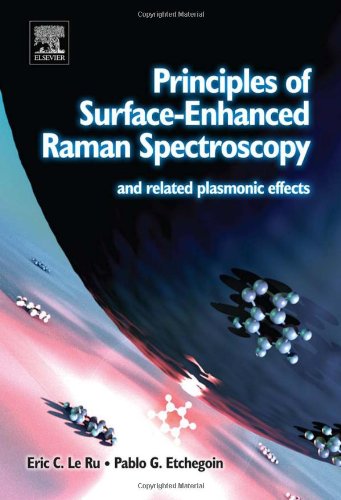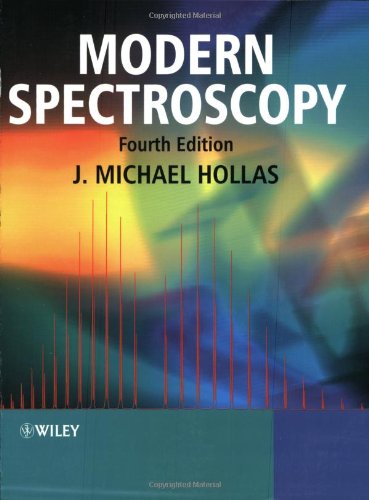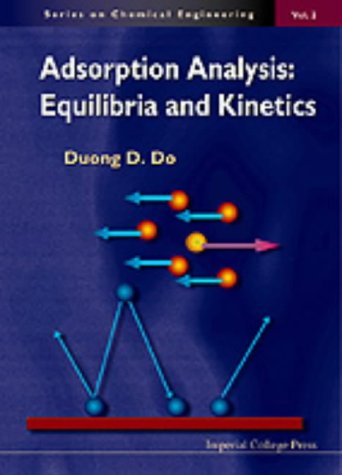Eric Le Ru, Pablo Etchegoin0444527796, 978-0-444-52779-0
Table of contents :
Cover Page
……Page 1
Copyright page……Page 2
Preface……Page 3
Notations, units and other conventions……Page 6
What is SERS? — Basic principles……Page 9
SERS substrates……Page 11
SERS probes……Page 14
Example……Page 16
SERS enhancements……Page 17
Sample preparation and metal/probe interaction……Page 18
Main characteristics of the SERS signals……Page 19
Related techniques……Page 21
Applications of SERS……Page 22
SERS vs fluorescence spectroscopy……Page 23
Brief history of SERS……Page 25
Current `hot topics’……Page 28
General outline of the book……Page 31
General `spirit’ of the book……Page 32
Different reading plans……Page 33
Raman spectroscopy and related optical techniques……Page 36
The discovery of the Raman effect……Page 37
Some applications of Raman spectroscopy……Page 38
Raman spectroscopy instrumentation……Page 39
The energy levels of molecules……Page 40
Spectroscopic units and conversions……Page 43
Optical absorption……Page 45
Emission and luminescence……Page 46
Scattering processes……Page 49
The concept of cross-section……Page 53
The Raman cross-sections……Page 57
Examples of Raman cross-sections……Page 60
Mechanical analogs……Page 64
Optical absorption and UV/Vis spectroscopy……Page 66
Fluorescence spectroscopy……Page 70
Photo-bleaching……Page 74
Phenomenological approach to Raman scattering……Page 77
Dipolar emission in vacuum……Page 78
The concepts of polarizability and induced dipole……Page 80
The linear optical polarizability……Page 82
The local field correction……Page 84
Polarizabilities and scattering cross-sections……Page 87
Final remarks on the phenomenological description……Page 93
General considerations……Page 95
A primer on vibrational analysis……Page 96
The Raman tensor……Page 98
Link to the Raman polarizability……Page 99
A brief overview of related Raman scattering processes……Page 104
Quantum (or semi-classical) approach to Raman scattering……Page 106
Justification of the classical approach……Page 107
The quantization of vibrations……Page 108
The full expressions for the Raman cross-section……Page 109
The anti-Stokes to Stokes ratio……Page 112
More on vibrational analysis……Page 113
More on symmetries and Raman selection rules……Page 121
Modeling of molecular structure and vibrations……Page 124
Summary……Page 126
Introduction to plasmons and plasmonics……Page 128
The optical properties of noble metals……Page 129
The Drude model of the optical response……Page 131
The optical properties of real metals……Page 132
What makes the metal–light interaction so special?……Page 134
The plasmon confusion……Page 138
Definition and history……Page 139
The relation between plasmons and the dielectric function……Page 142
Electromagnetic modes in infinite systems……Page 143
Electromagnetic modes of a system of material bodies……Page 148
Classification of electromagnetic modes……Page 150
Other properties of electromagnetic modes……Page 151
Summary and discussion……Page 153
Surface plasmon–polaritons on planar interfaces……Page 155
Electromagnetic modes for a planar dielectric/metal interface……Page 156
Properties of the SPP modes at planar metal/dielectric interfaces……Page 162
Coupling of PSPP modes with light……Page 166
PSPP resonances at planar interfaces……Page 171
Local field enhancements and SPPs at planar interfaces……Page 174
SPP modes on planar interfaces: A brief summary……Page 180
Introduction to localized SPPs……Page 181
LSP modes of a metallic sphere……Page 182
LSP resonances……Page 184
Local field enhancements and LSP……Page 185
Interaction of SPPs — gap SPPs……Page 186
Applications of surface plasmon resonances……Page 188
Local field enhancements……Page 189
SERS enhancement factors and related topics……Page 191
Definition of the SERS enhancement factors……Page 192
General considerations……Page 193
The analytical point of view……Page 196
The SERS substrate enhancement factor — Experimental approach……Page 197
The SERS cross-section and single-molecule EF……Page 198
The SERS substrate enhancement factor — Formal definition……Page 203
Discussion and merits of the various definitions……Page 204
Experimental measurement of SERS enhancement factors……Page 206
The importance of the non-SERS cross-section……Page 208
Example of AEF measurements……Page 209
Link between SSEF definition and experiments……Page 211
Analysis of the EM problem of SERS……Page 215
Local field enhancement……Page 218
Radiation enhancement……Page 220
Other EM effects……Page 222
The common |E|4 -approximation to SERS enhancements……Page 223
Introduction……Page 225
The link between spontaneous emission and dipolar emission……Page 226
Modification of dipole emission: definitions of enhancement factors……Page 230
Spontaneous emission and self-reaction……Page 235
The Poynting vector approach……Page 237
Spontaneous emission and the optical reciprocity theorem……Page 239
Definitions, notations, and assumptions……Page 243
The SERS EM enhancement: general case……Page 246
SERS EM enhancements in the back-scattering configuration……Page 251
Similarities and differences between SEF and SERS……Page 254
Modified (enhanced) absorption……Page 255
Modified fluorescence quantum yield……Page 256
Fluorescence quenching and enhancement……Page 257
Other EM effects in SERS……Page 259
Fluorescence quenching in SERS……Page 260
Photo-bleaching under SERS conditions……Page 261
Non-radiative effects in SERS……Page 263
Introduction……Page 264
The charge-transfer mechanism……Page 265
Electromagnetic contribution to the chemical enhancement……Page 267
Summary……Page 269
Calculations of electromagnetic enhancements……Page 271
The EM problem……Page 272
Far field and local/near field……Page 275
Some key EM indicators……Page 279
The electrostatic approximation (ESA)……Page 285
Other approximations……Page 291
Analytical tools and solutions……Page 292
The perfect sphere……Page 293
Other approaches……Page 295
A brief overview of the EM numerical tools……Page 296
A semi-analytical approach: the discrete dipole approximation……Page 298
Direct numerical solutions……Page 300
Other approaches……Page 303
EM enhancements and plasmon resonances: examples and discussion……Page 304
The image dipole approximation for the self-reaction field……Page 305
Enhancement and quenching at plane metal surfaces……Page 308
A simple example in detail: The metallic sphere……Page 312
Metallic sphere in the ES approximation……Page 313
Localized surface plasmon resonances and far-field properties……Page 319
Local field effects……Page 329
Distance dependence……Page 340
Non-radiative effects — surface-enhanced fluorescence……Page 342
The effect of shape on the EM enhancements……Page 347
Shape effects on localized surface plasmon resonances……Page 348
Shape effects on local fields……Page 351
Summary of shape effects……Page 358
Coupled localized surface plasmon resonances and SERS……Page 359
EF distribution and hot-spot localization……Page 364
Additional effects……Page 366
Nano-particles on a supporting substrate……Page 367
Factors affecting the EM enhancements: Summary……Page 369
Metallic colloids and other SERS substrates……Page 371
Silver vs gold……Page 372
Citrate-reduced colloids……Page 373
Other types of colloids……Page 375
Dry colloids and other `2D planar’ SERS substrates……Page 377
Microscopy……Page 379
Extinction or UV/Vis spectroscopy of SERS substrates……Page 381
Other techniques: dynamic light scattering (DLS) for colloidal solutions……Page 385
Introduction……Page 389
The van der Waals interaction between metallic particles……Page 390
The screened Coulomb potential……Page 393
The DLVO interaction potential……Page 398
Colloid aggregation within the DLVO theory……Page 399
Molecular (analyte) adsorption and SERS activity……Page 403
Colloid aggregation for SERS……Page 407
Focus on the `chloride activation’ of SERS signals……Page 410
SERS from `dried’ colloidal solutions……Page 411
SERS signal fluctuations……Page 414
Introduction……Page 418
Early evidence for single-molecule detection……Page 420
Langmuir–Blodgett monolayers……Page 426
Bi-analyte techniques……Page 428
Single-molecule SERS enhancement factors……Page 436
Single-molecule SERS: Discussion and outlook……Page 438
Introduction to TERS……Page 439
TERS with an atomic force microscope (AFM)……Page 440
TERS with a scanning tunneling microscope (STM)……Page 441
Theoretical calculations on tips……Page 443
Discussion and outlook……Page 445
New substrates from nano-technology……Page 446
Chemical synthesis of metallic nano-particles……Page 447
Self-organization……Page 450
Nano-lithography……Page 451
Adaptable/Tunable SERS substrates……Page 454
Micro-fluidics and SERS……Page 457
A simple theory of optical forces……Page 458
Radiation pressure in colloidal fluids……Page 460
Optical trapping of metallic particles……Page 461
Optical forces on molecules……Page 462
Analyte engineering and surface functionalization……Page 463
Substrate reproducibility and SERS commercialization……Page 465
Epilogue……Page 466
Computing aspects of DFT……Page 468
Principles of DFT……Page 470
Important parameters……Page 472
Principle……Page 474
Geometry optimization using DFT……Page 475
Limitations of DFT calculations for Raman……Page 476
Brief overview of the input and output files……Page 477
Common units and definitions in Raman calculations from DFT……Page 480
Normal mode patterns and Raman tensors……Page 482
Raman tensor and vibrational pattern visualizations……Page 488
Depolarization ratio breakdown under SERS conditions……Page 492
Principle……Page 494
Calculation of bond polarizabilities……Page 495
Practical implementation……Page 498
Bond-polarizability analysis……Page 499
Raman polarizabilities……Page 500
A brief comment on the symmetry……Page 501
The equations……Page 502
Maxwell’s equations for harmonic fields in vacuum……Page 504
Microscopic and macroscopic fields……Page 506
The electromagnetic response of the medium……Page 507
Electric polarization and magnetization……Page 508
Constitutive relations……Page 511
Boundary conditions between two media……Page 515
The microscopic field……Page 516
Plane waves in media……Page 518
Electromagnetic problems in SERS……Page 520
Link with the static approach……Page 521
Principle……Page 526
Example: linear optical polarizability of rhodamine 6G……Page 528
Dielectric function in solids……Page 529
The metallic limit……Page 530
Summary……Page 531
Analytical expression……Page 532
Comparison to experimental results……Page 533
Analytical expression……Page 534
Comparison to experimental results……Page 535
Limitations of the models……Page 536
Comparison between Ag and Au……Page 537
General expressions……Page 539
Evanescent plane waves……Page 541
Inhomogeneous plane waves: hybrid propagating/evanescent waves……Page 542
Plane wave polarization at an interface……Page 543
General solution for plane waves at a planar interface……Page 544
Physical waves in a semi-infinite region……Page 548
The Fresnel coefficients……Page 552
Surface modes……Page 553
Reflection/Refraction at a planar interface……Page 558
Incident, reflected, and transmitted waves……Page 559
TM or p -polarized waves……Page 560
TE or s -polarized waves……Page 563
Special cases……Page 565
Principle……Page 566
p -polarized or TM waves……Page 567
Implementation in Matlab……Page 569
Dipole emission close to a planar interface……Page 572
Radiative decay rates……Page 573
Some definitions……Page 575
Ellipsoidal coordinates……Page 576
The electrostatic solution……Page 577
Some important EM indicators for ellipsoids……Page 580
Some aspects of the numerical implementation……Page 583
Geometrical factors……Page 585
Surface averages……Page 586
Geometrical factors……Page 587
Surface averages……Page 588
Limit of large aspect ratio……Page 589
Motivation……Page 590
The electromagnetic equations……Page 591
The vectorial wave equation in spherical coordinates……Page 592
Scattering by a sphere……Page 594
Optical resonances of the sphere……Page 597
Some aspects of the practical implementation of Mie theory……Page 598
Basic formulas of Mie theory……Page 599
Spherical coordinates: A brief reminder……Page 600
Definition and properties of the vector spherical harmonics……Page 601
Expressions for the susceptibilities……Page 606
More on optical resonances……Page 608
Absorption, scattering, and extinction for an incident beam……Page 609
Absorption and radiation for a localized source……Page 612
The local field at the surface……Page 613
Expansion of a plane wave in vector spherical harmonics……Page 614
Extinction, scattering, and absorption for plane wave excitation……Page 615
Emitter close to a sphere……Page 616
Coated spheres……Page 622
Multiple spheres and generalized Mie theory (GMT)……Page 626
Common problems……Page 627
Some aspects of our implementation……Page 628
References……Page 630
Index……Page 655







Reviews
There are no reviews yet.